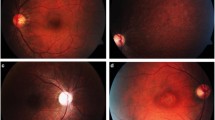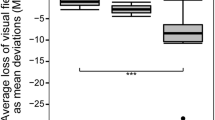Abstract
Background: Optic atrophy, attenuation of the oscillatory potentials (OPs) of the electroretinogram (ERG), and enlargement of corneal endothelial cells, have been reported in patients with spinocerebellar ataxia type 1 (SCA1). These patients have a trinucleotide repeat expansion in the SCA1 gene and show neurological anticipation. The purpose of this study was to determine whether the ophthalmological findings are correlated with the neurological disorders, and whether ophthalmological anticipation is present in patients with SCA1. Methods: The visual acuity, ERGs, and corneal endothelial cell density were examined in 14 patients whose DNA analysis revealed an expanded trinucleotide repeat in an allele of the SCA1 gene. The results of the tests were compared with the trinucleotide repeat number and the duration of the neuronal disease. Results: The neurological disorders in the patients showed anticipation. The negative correlation between the trinucleotide repeat number and the neurological disorder was statistically significant (P<0.0001). However, the correlations between trinucleotide repeat number and visual acuity, amplitude of OPs, and corneal endothelial cell density were not significant. Statistically significant correlations were found between the duration of the neuronal disease and the visual acuity, OPs, and corneal endothelial cell density (P<0.0001, P=0.0004, and P<0.0001, respectively). The ophthalmological disorders were prominent in patients who had neuronal disease for more than 10 years. Conclusion: Unlike the neurological findings, the ophthalmological disorders in patients with SCA1 were not correlated with the trinucleotide repeat number of the SCA1 gene. The ophthalmological findings were most highly correlated with the duration of the neuronal disease.
Similar content being viewed by others
Author information
Authors and Affiliations
Additional information
Electronic Publication
Rights and permissions
About this article
Cite this article
Abe, T., Abe, K., Tsuda, T. et al. Ophthalmological findings in patients with spinocerebellar ataxia type 1 are not correlated with neurological anticipation. Graefe's Arch Clin Exp Ophthalmol 239, 722–728 (2001). https://doi.org/10.1007/s004170100342
Received:
Revised:
Accepted:
Published:
Issue Date:
DOI: https://doi.org/10.1007/s004170100342




